By JIM SILVERNAIL and EDDIE BUCHANAN
The modern fireground is a dynamic and evolving challenge that requires an efficient yet effective use of the specific, initial-arriving firefighting force to contain, control, and mitigate all hazards associated with structure fires. It has been proven that fires are growing at an exponentially higher rate, with higher heat release rates in today’s structures, which are not built to withstand long durations of fire involvement. Tactics must focus on implementing the fireground functions that make a rapid impact and achieve the objectives of quickly locating, containing/confining, and extinguishing the fire prior to further progression. Traditionally, this has taken the form of a blitz attack using an engine’s master stream device and tank water. Today, handlines are being added to the quick-attack toolbox.
- The Modern Fire Attack
- Fast Forward: Water Supply for the Modern Fireground
- Today’s Evolving Fire Attack
Removing the hazard (fire) is the essential component of achieving the fire service objectives of saving life and protecting property. For most fire service agencies, this means firefighters must make the most out of what resources we have on arrival, prioritizing essential functions, and developing proficient methods for quick attack delivery.
Fast Water Always Wins
Fire agencies that are routinely successful on the fireground quickly deploy attack lines and place water at the seat of the fire. These entities have the resources and systems in place to make their efforts effective in achieving their objectives. These systems are referred to as standard operating guidelines (SOGs). SOGs provide a template that prioritizes the fireground functions that must be implemented and coordinated to make the greatest impact on the situation. However, note that all agencies do not have the same capabilities or availability of resources. Fireground operations must be designed to circumstantially implement tactics that most efficiently use your specific available resources for effective fireground objective achievement.
National Fire Protection Association (NFPA) 1410, Standard on Training for Emergency Scene Operations, provides a variety of water supply, handline, and master stream evolutions designed to serve as a benchmark for fire departments to evaluate their ability to generate a fast-water fire attack. Departments that do not already have tactical guidelines or SOGs in place and are discussing their fire attack game plan can use this standard as a reference or basis to generate their own tactical guidance documents.
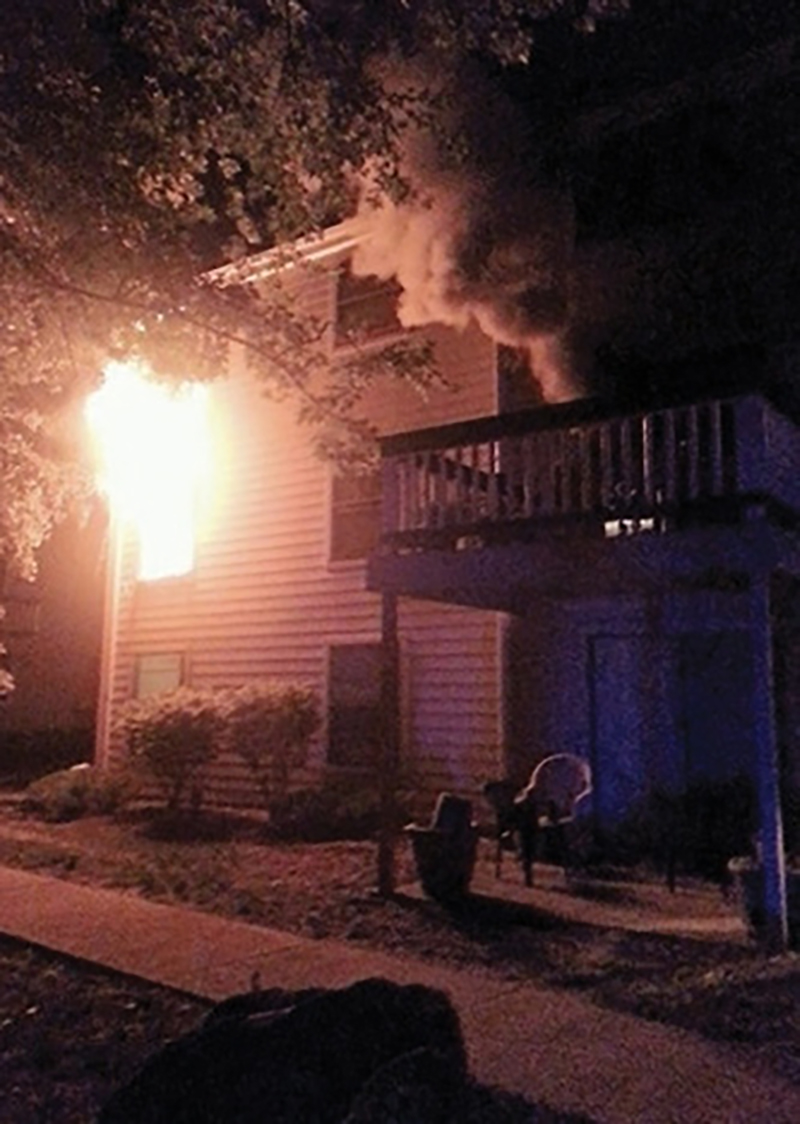
(1) Fire autoexposing from the window of a multifamily apartment building will spread to upper floors and to the attic through the melted plastic soffit if not controlled rapidly. (Photos 1-5 by Jim Silvernail.)
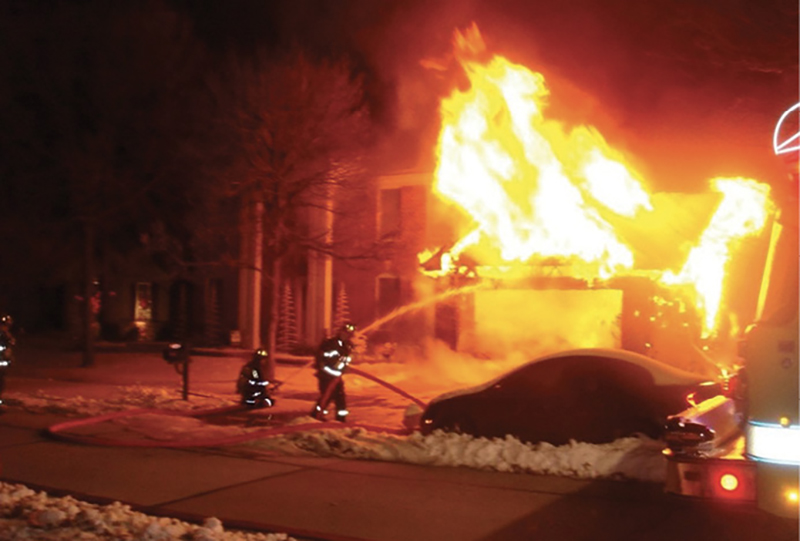
(2) Tactics must be implemented to deploy rapid fire attack to control and contain fire spread.
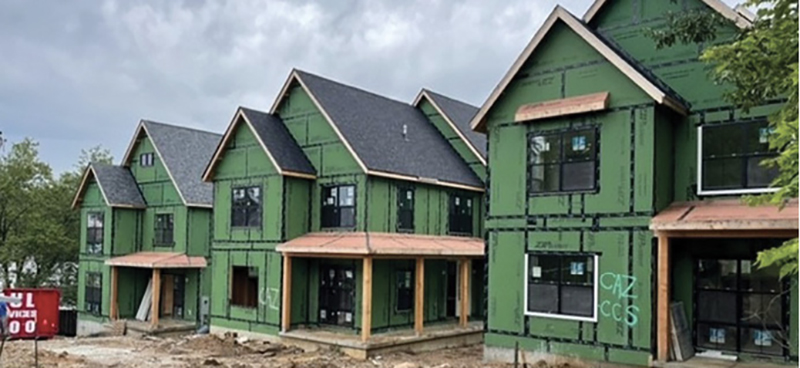
(3) Modern Type V building construction presents various challenges that require effective tactics that must be delivered without delay.
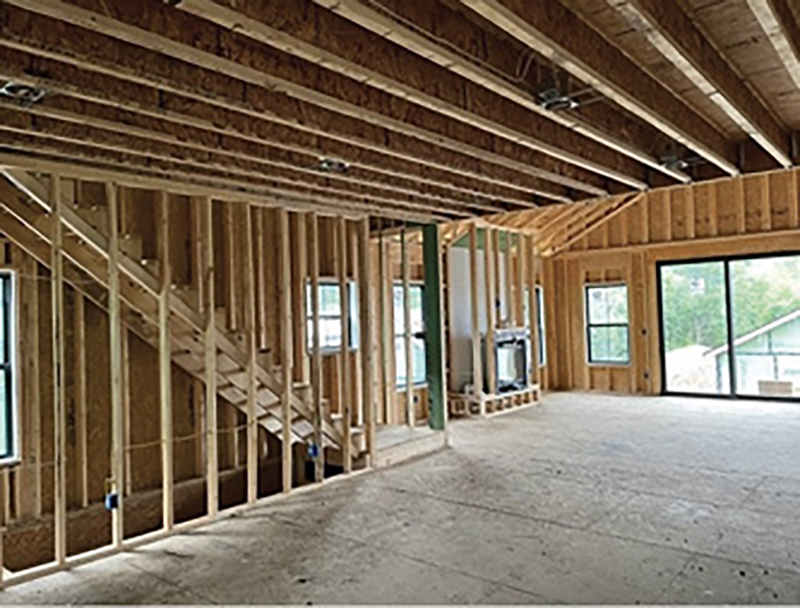
(4) Engineered floor joists replace full wooden structural components. If exposed to fire or high temperatures, they can fail within minutes.

(5) New construction patterns include open floor designs with high vaulted ceilings, creating paths for rapid, uninhibited fire propagation.
Regardless of your agency’s specific variables of resources, staffing, or response area characteristics, the concept, “No other action taken on the fireground saves more lives and protects more property than the proper size attack line, stretched to the correct location, and placed into service at the proper time,” is consistent for all fireground operations. The big question we must address is, when is the proper time? The answer is always: as soon as possible. Therefore, using this concept, we can further prioritize the fireground functions that must be implemented in a coordinated manner to hastily place attack lines or water delivery in a rapid method.
Should We Deliver a Fast Fire Attack?
To place an attack line into service rapidly, there are possibly numerous functions that must be coordinated. Every structure fire has its unique set of variables and challenges; no fire is the same. However, we should expect to have to facilitate the line and not take for granted an easy stretch. Initial, facilitating actions that assist with attack line deployment include the following:
- Establishing water supply.
- Forcible entry.
- Fire location.
- Search and rescue.
- Recognizing the flowpath, conducting ventilation, or building control (i.e., limiting ventilation until coordinated fire attack occurs).
Fireground strategy is not simply placing “the wet stuff on the red stuff”; there is a strategic methodology that must drive tactics. The strategic sequence in fireground control and mitigation includes the following:
- Fire location (including access).
- Fire containment/confinement.
- Extinguishment.
Initial-arriving companies must not take fire location and containment/confinement for granted. If resources are not properly coordinated to access and locate fire, valuable time will be lost, and companies will not get to the seat of the fire in time, allowing for rapid fire growth. Examples of this are fires located in concealed spaces such as walls, attics, and knee walls. The fire must also be contained before final extinguishment. Fire officers must have the ability to understand not only where the fire is located but also where is it going. Direct extinguishment without predicting the fire’s path could lose containment from the area of origin. This phenomenon is best illustrated using the example of a fire that has autoexposed from an exterior opening, traveling both vertically upward and horizontally across the flowpath.
The modern Type V building construction of most newer homes is a common enemy of the fire service and illustrates the necessity for effective tactics that must neutralize the hazard without delay and tactical error. New technologies seek cheaper means to build these structures. Building patterns can include lightweight construction using engineered structural members that have less mass. These structural elements can lose their integrity within four to eight minutes from the initial start of the fire. Less mass to structural members also means larger void spaces, increasing the potential for rapid fire spread. In addition, the soffits that are designed to cover the eaves and create a barrier between the exterior wall and attic space are not fire resistant. They will melt and burn away when exposed to fire, allowing for external fire spread into the attic and voids.
Initial-arriving companies must find the best solution to quickly contain fires to the area of origin. In the example illustrated in the Type V (wood frame/combustible) modern construction, can a fire that has autoexposed to the exterior be contained by an interior attack line? That answer truly depends on the growth of the fire and the ability to place the line in service rapidly, navigating the interior. As was discussed earlier, there are numerous functions that may need to take place to facilitate this action. These fires can rapidly spread to upper floors and to the attic through the plastic soffit. Keep in mind that this isn’t complete extinguishment; it’s an attempt to contain the fire. The real extinguishment occurs at the seat of the fire.
If our goal was to contain the fire and control the interior compartment by removing heat release rates, why was our past practice to pass an active fire without tactical intervention? The practice was not accepted and forbidden by many fire agencies throughout the United States. Prior to Underwriters Laboratories (UL) studies, most firefighters were taught never to flow water from an exterior advantage because of the harmful impacts of pushing fire and harming possible entrapped occupants. However, there has been a drastic change to the tactical approach regarding the theory of initial water application and the coordination of ventilation. What has changed? The renaissance of modern fire attack occurred.
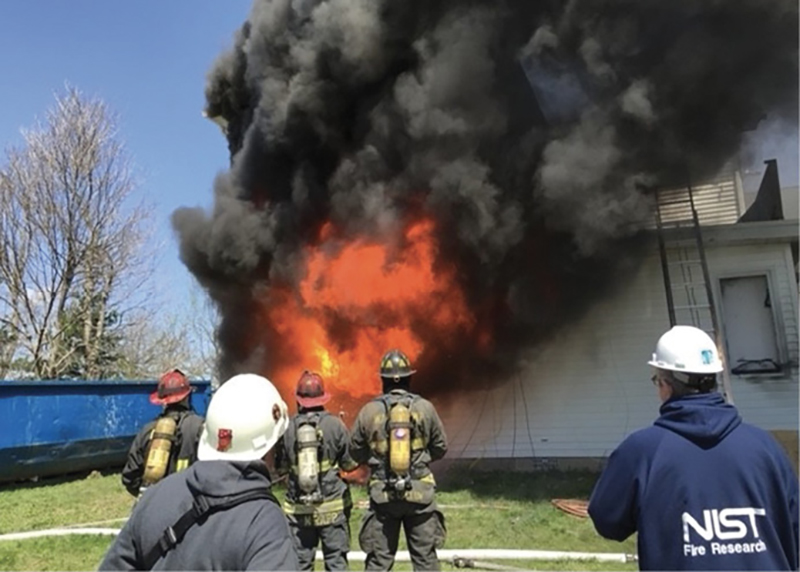
(6) A scene from FDIC International H.O.T. training, where the fire was controlled with less than 300 gallons of water. (Photos 6-7 by Eddie Buchanan.)
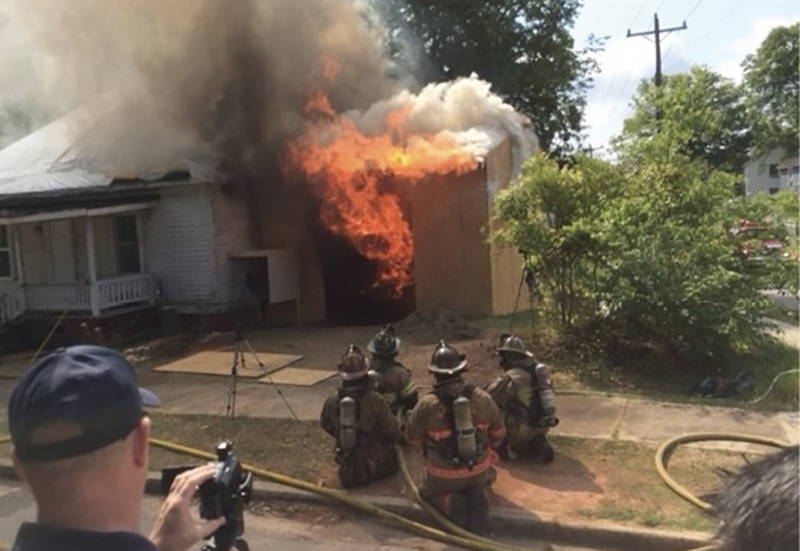
(7) Research burns in Spartansburg, South Carolina, created through a partnership with FEMA’s Assistance to Firefighters Grants program, the International Society of Fire Service Instructors, the National Institute of Standards and Technology, and Underwriters Laboratories.
Research to Justify Tactical Implementation
To state one of the primary lessons learned from the UL research over the years as simply as possible, a primary goal of first-arriving fire units is to get water into the highly pressurized areas of the structure fire as soon as possible. High pressure is typically synonymous with high heat release rates and represents a tremendous threat to occupants inside the structure. Such a tactic may occur as the fire attack team advances through a doorway and down a hallway toward the seat of the fire, “flowing and going” as they advance. They may use some of the latest techniques to come from the UL research such as using building features to distribute their fire stream as broadly across the heated fuels as possible by “bouncing” the stream off of door jambs or windowsills. Rapid water application may also be achieved from exterior positions when the fire attack team has direct access to a highly pressurized opening or flame showing from an opening on arrival. Nozzle technique and stream placement are important for water application. Research has shown that straight/solid streams “cut” through the air or flowpath, allowing ventilation openings to continue to operate as a vent. In such cases, avoid occluding the vent opening with a fog stream or rapid stream movement.
In contrast to exterior water application, interior water application may vary depending on the available vent openings and flowpath configuration. If an exhaust opening is present beyond the seat of the fire, the attack team may select nozzle patterns or a wider stream to entrain air into the fire stream to move heat and gases toward the vent opening. This incorporates concepts accepted as “hydraulic ventilation” as part of the fire attack process. This same tactic is contraindicated when there is no exhaust ventilation opening beyond the seat of the fire, calling for a steady solid or straight stream during movement down the hallway. This points to the importance of coordinating ventilation with fire attack so that the nozzle firefighter is aware of the ventilation and flowpath configuration to make the best use of the water he has at his disposal. This brings more technique and consideration to the nozzle firefighter position, much more than just opening the bail. In some cases, it may be appropriate to use water applications that entrain maximum air while, in other cases, such tactics should be avoided. The nozzle firefighter must assess conditions, apply fire dynamics considerations in real time, and choose the appropriate technique for the conditions at that moment.
For Hanover (VA) Fire-EMS, long before there was a SLICE-RS (Size-up, Locate the fire, Isolate the flowpath, Cool from a safe distance, Extinguish, Rescue, and Salvage) concept to incorporate fire dynamics research into tactical operations, there was a section in its tactical guidelines entitled the “750-Fast Concept.” This section describes how, given the limited staffing, resources, and extended response times during initial fire attack, the primary objective of the first-arriving engine was to get the 750 gallons carried on their pumpers to the seat of the fire as quickly as possible. Any barriers to rapid water application would likely switch from an offensive to a defensive attack because of rapid fire growth, building construction, and extended response times in a suburban/rural environment. Beyond any obvious rescues or other unforeseen, extenuating circumstances, the best thing that three firefighters arriving on a single engine can do is knock down the fire as quickly as possible.
As the fire dynamics research continues, attitudes toward water supply are being reconsidered, particularly in settings that require rural water supply operations or water shuttles. In rural water settings, great effort and resources are required to establish a sustained fire flow over a long period of time. The recent research has caused incident commanders (ICs) to rethink the effort put into establishing such a water supply operation. Of course, it’s always best to have a backup plan if the initial fire attack is unsuccessful, but it’s also important to consider directing initial efforts to the primary fire attack rather than preparing for an extensive shuttle operation.
For example, prior to the recent research, a first-arriving tanker/tender would have arrived on scene, dropped portable tanks, dumped its water tank, and departed for the fill site. This requires two to three firefighters to manage the deployment of equipment and water and get the empty unit en route to the fill site. Based on what has been learned from the research, it may be a better use of resources to commit the tanker/tender to the fireground to nurse the primary pumper, particularly when the IC intends a rapid transitional/interior fire attack. This can provide extra personnel to support the initial fire attack. If you get the initial water where it needs to go quickly, you likely already have enough water on scene with that engine-tanker configuration. Obviously, if the fire extended well beyond the area of origin and a defensive attack is appropriate, then traditional rural water supply operations are appropriate.
A great resource for fire officers is NFPA 1700, Guide for Structural Fire Fighting. This guide offers a comprehensive description of the research to date and tactics appropriate for various conditions in an “a la carte” manner. A combination of NFPA 1700 and 1410 will keep training officers busy drilling their companies to deliver fire streams quickly where they need to go to quickly to knock down the fire and improve the environment for both civilians and firefighters.
So, although it seems that the fireground has become more complex, and the research continues to refine our tactics for operating in various environments and settings, the mission essentially remains the same. In most cases, the best the thing the fire department can do, particularly when operating with limited resources, is simply to knock down the fire. It’s easy to be busy with the various support tactics that are essential to fireground success, but with limited resources, the IC must, at times, make difficult choices. It would be nice to provide vertical ventilation, a dedicated forcible entry, and a search team, but when the IC has only three firefighters (or fewer), choices will have to be made. When in doubt, put the fire out.
Implications of the Tactical Renaissance
Over the past 250 years of providing fire protection, the U.S. fire service’s mission and objectives have not changed. We can also argue that structural firefighting strategy has also remained a constant. However, our tactical approaches have changed greatly through theory and engineering advances in equipment, including apparatus and personal protective equipment. We can now also add research and scientific fact to the list. As leaders and members of the firefighting profession, we must use the findings of UL research responsibly and combine them with our existing practices to effectively mitigate and solve our fireground objectives. Our understanding of behavior has been enhanced, dictating a modification to tactical implementation.
One concept that also hasn’t changed is that fast water always wins. The quicker we mitigate the hazard or control the fire, the safer the environment becomes, and the closer we are to achieving our objectives. The only difference now is understanding how we can apply water and how the fire environment (pressure) will react. In the simplest terms, flowing water from an opposing vantage point without entraining air will not push the fire or move it into an unburned area. Why pass large volumes of fire and not attempt to contain the fire immediately? Fast water always wins! We should also note that not all fires are the same, nor can they be accessed by the exterior, and crews often have to initiate interior offensive operations to locate, contain/confine, and extinguish the fire. However, fire behavior remains a constant.
Change is a very challenging concept not only for the fire service but for all of humanity. The worst comment that can be made is, “This is the way we have always done it.” Firefighters must be forward thinkers and use the scientifically proven facts that safely, effectively, and efficiently help achieve objectives. This does not diminish the experience of fire service veterans; it simply enhances their abilities on the fireground to better achieve their established directives of rapidly putting water on the fire, containing and extinguishing the hazard, and saving lives and property within the process.
JIM SILVERNAIL is a 25-year fire service veteran and chief of the Kirkwood (MO) Fire Department. He is also a graduate of the National Fire Academy’s Executive Fire Officer program and is internationally accredited by the Center for Public Safety Excellence as a Chief Fire Officer. Silvernail is the author of Suburban Fire Tactics (Fire Engineering, 2013) and co-author of the video series “Suburban Fire Tactics from the Right Seat” (Fire Engineering, 2016). He was a lead instructor at the St. Louis County (MO) Fire Academy, specializing in truck company operations. Silvernail has written numerous articles for Fire Engineering, has been a workshop instructor at FDIC International since 2011, and presents at various regional conferences. He serves on the Fire Engineering and FDIC International advisory boards and served on the board of the International Society of Fire Service Instructors and as a planning team manager member with FEAM US&R MO-TF1. Silvernail also serves as the first vice president of the International Association of Fire Chiefs Missouri Valley Division.
EDDIE BUCHANAN is a 40-year fire service veteran who retired as assistant chief with Hanover (VA) Fire & EMS in May 2022. He is a past president of the International Society of Fire Service Instructors and is the 2015 recipient of the George D. Post Instructor of the Year Award from the International Society of Fire Service Instructors. Buchanan serves on the executive advisory board of Fire Engineering and FDIC International and is author of Volunteer Training Officer Handbook (Fire Engineering). He serves on the NFPA Technical Committee on Fire Service Training and the committee for NFPA 1700, Guide for Structural Fire Fighting. He is also a past board member of the Volunteer/Combination Officer Section of the International Association of Fire Chiefs.

